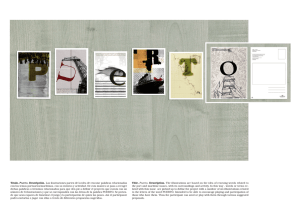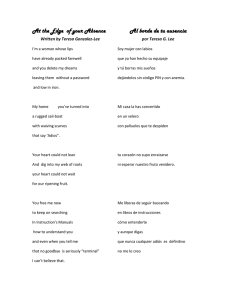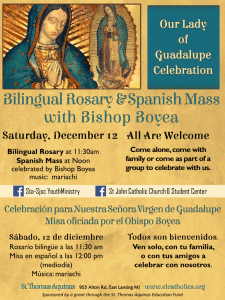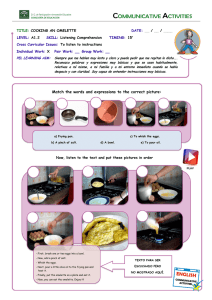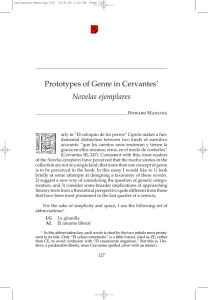Dressing Up and Dressing Down: Clothing and Class - H-Net
Anuncio
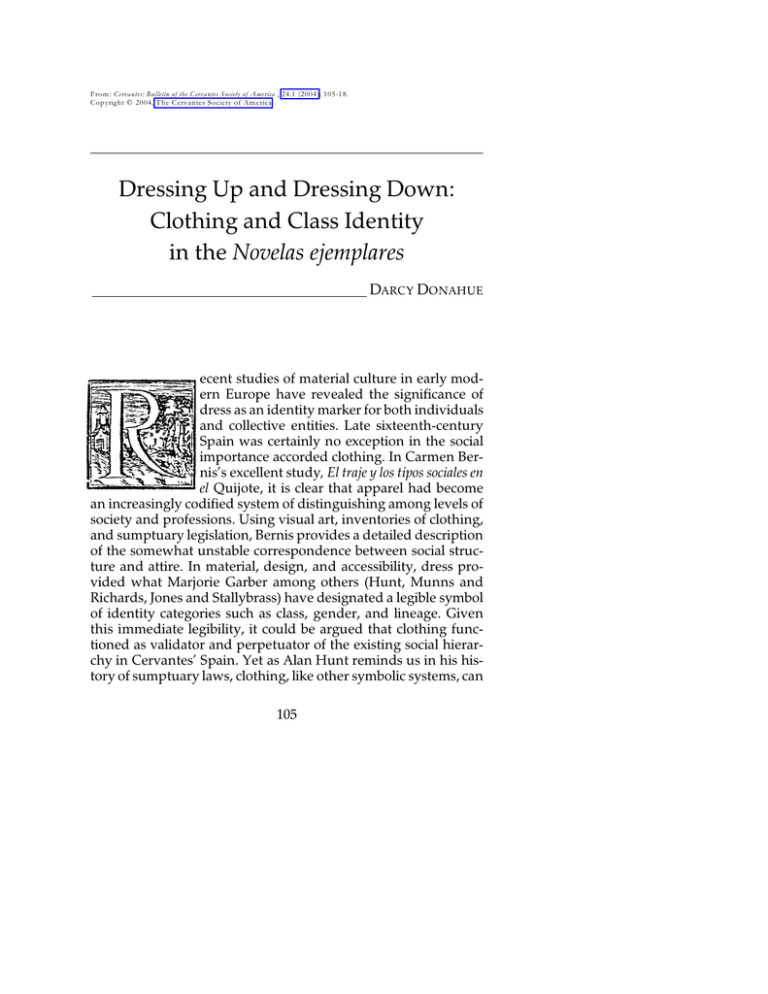
From : Cervantes: Bulletin of the Cervantes Society of A merica , 24.1 (2004): 105-18. C opyright © 2004, T he Cervantes Society of Am erica. Dressing Up and Dressing Down: Clothing and Class Identity in the Novelas ejemplares DARCY DONAHUE ecent studies of material culture in early modern Europe have revealed the significance of dress as an identity marker for both individuals and collective entities. Late sixteenth-century Spain was certainly no exception in the social importance accorded clothing. In Carmen Bernis’s excellent study, El traje y los tipos sociales en el Quijote, it is clear that apparel had become an increasingly codified system of distinguishing among levels of society and professions. Using visual art, inventories of clothing, and sumptuary legislation, Bernis provides a detailed description of the somewhat unstable correspondence between social structure and attire. In material, design, and accessibility, dress provided what Marjorie Garber among others (Hunt, Munns and Richards, Jones and Stallybrass) have designated a legible symbol of identity categories such as class, gender, and lineage. Given this immediate legibility, it could be argued that clothing functioned as validator and perpetuator of the existing social hierarchy in Cervantes’ Spain. Yet as Alan Hunt reminds us in his history of sumptuary laws, clothing, like other symbolic systems, can 105 106 D ARCY D ONAHUE Cervantes be manipulated by the individual and by groups both within and against prevailing ideologies and practices. The potential of dress to both reinforce and undermine existing norms did not escape Cervantes. It is evident throughout his work that apparel is an important instrument of personal and cultural expression and nowhere more than in the Novelas ejemplares. Operating upon the assumption that Spain was a class-divided society, in what follows I will explore the nature of the relationship between clothing and class identity in a few of these short works.1 Though costume figures significantly in all of the Novelas ejemplares, my analysis will be limited to those in which the primary action occurs in Spain. In a culture of appearances such as that of the early modern Spanish city, attire could provide socio-economic readability, although an increasingly unreliable one. According to Bernis, “cuando los contemporáneos de Cervantes opinaban sobre las diferencias que se debían guardar en el vestir según la condición social de cada cual, distinguían dos categorías: las personas principales por una parte y las gentes comunes y ordinarias por otra. …El traje no siempre reflejaba claramente las diferencias sociales, pues las gentes comunes trataban de imitar en el modo de vestir a las principales” (359). Furthermore, if we can believe the statement of Fray Tomás de Trujillo in his Libro llamado reprobación de los trajes y abuso de juramentos (1563), the manipulability of clothing involved not only a large scale crossing over between the social classes, but also, within individual wardrobes, the possibility of assuming various identities: “Desapruebo tantas diferencias de ropas: unas para la plaza, otras para la casa; unas para levantar, y otras para rezar; unas para el camino, y otras para la posada…pareciendo unas veces montero, otras caballero; unas soldado, otras medico; unas labrador pobre, otras ciudadano rico; como representador de muchos dichos en una sola comedia” (quoted in Bernis 19). In such instances, identity becomes a perfor1 Giddens defines a class-divided society as “a society in which there are classes, a class relation always being inherently a conflict relation in the sense of opposition of interest, but it is not a society in which class analysis provides the key to unlocking all the most significant features of the institutional order” (162). 24.1 ( 2 0 0 4 ) Dressing Up and Down in the Novelas ejemplares 107 mance, a form of self-presentation, albeit conditioned and to some extent controlled by external forces such as dress codes, personal wealth, and the availability of certain materials. It is clearly this slippage between one social category and another which occasioned the efforts of both Church and secular authorities to regulate the display and, ostensibly, the possession of garments and other bodily adornments.2 Yet despite the barrage of sumptuary legislation in the decade before the publication of the Novelas ejemplares in 1613, these laws were on the whole difficult to enforce; the situation seems to have been more fluid than is often imagined, particularly in the cities, where members of different social strata were in frequent contact. In fact, as Richard Sennett points out, in an urban environment hierarchical dress rules become increasingly unenforceable since, in a world of strangers, it becomes increasingly difficult to know what some stranger is “entitled” to wear (66). The manipulability of attire takes various forms, as Ann Jones and Peter Stallybrass remind us in Renaissance Clothing and the Materials of Memory. Clothes can be put on, removed and exchanged, assembled and disassembled. Furthermore, these actions may be carried out voluntarily by an individual or form part of rituals and transactions performed by others. Fabric, colors, and styles carry associations which may empower the wearers, but may also restrict or impose obligations upon them. In the case of Leonora, the child-bride of “El celoso extremeño” whose parents have virtually sold her to the wealthy indiano Carrizales, her new wardrobe represents a substantial gain in wealth and prestige, since “las [galas] que ella en su vida se había puesto no pasaban de una saya de raja y una ropilla de tafetán” (2: 180).3 Here, it is enough for the narrator to mention two of the most common materials for the reader to recognize this shift in financial status, 2 According to the eighteenth-century jurist and historian of sumptuary law Juan Sempere y Guarinos (Vol. 2, Chapters 2 and 3), the reigns of Felipe II and Felipe III were a high-watermark of conspicuous consumption and the accompanying legislation. 3 Quotations from the Novelas ejemplares are taken from the edition of AvalleArce. 108 D ARCY D ONAHUE Cervantes if not exactly in class, since Leonora is of an aristocratic background. Yet, the new and sumptuous apparel is also part of the physical enclosure which she must endure in her marriage to the jealous Extremaduran since she will wear it exclusively within the walls of her home-prison. Leonora brings no trousseau or dowry to the marriage, so Carrizales’ dressing of her signals the absolute rights he has acquired over her. The material gain is enough, however, to convince her noble but impoverished parents that they have acquired a good son-in-law. In the same novel, Loaysa, Leonora’s failed seducer, is a rich virote, or man of the barrio, who refashions himself as a crippled pauper musician in order to gain access to the palatial residence. One of several cases of dressing down which occur in the collection, it is an obvious form of masquerade. The narrator informs us that the “barrio people” are identifiable, among other things by their dress, which he refrains from describing “out of respect.” Curiously, the Porras text provides a detailed portrait of the clothed barrio man, perhaps more detailed than any other in the collection.4 The impression created is of well-heeled dandies, who spend a great deal of time and money on apparel, though according to Bernis’s taxonomy, not always of the finest quality or best taste. They wear the lechuguillo, or starched and frilly collar which was eventually banned, their shoes are tight enough to explode, also a sign of high style, their sleeves are of false silk, their swords are silver or gold plated and their gloves are perfumed, though with powders, and not the truly elegant ambergris. Above all, they wear their hair in copetes and they use unguents or algae to hold it in place. The copete, a recent addition to masculine hairstyles, came under sharp attack from many quarters as effeminate and un-Spanish.5 The rest of the description, however, leaves no doubt as to their expressed sexual preference for women. It is unclear why the Porras text adds this revealing portrait. In any 4 The lost Porras text, conserved in the edition of Isidro Bosarte, is reproduced by Schevill and Bonilla (Novelas exemplares 2: 171 and 173), whose text is in turn reproduced by Avalle-Arce 2: 232–33. On the derivative nature of the Porras text, see Stagg. 5 For a description and an illustration of this hairstyle, see Bernis 193. 24.1 ( 2 0 0 4 ) Dressing Up and Down in the Novelas ejemplares 109 event, after his successful entry into Carrizales’ mansion, Loaysa reverts to his former sartorial self, and again we receive a clear image of a dandy well aware of the effect of his clothed presence: “no estaba ya en hábitos de pobre, sino con unos calzones grandes de tafetán leonado, a la marineresca; un jubón de lo mismo con trencillas de oro, y una montera de raso de la misma color, con cuello almidonado, con grandes puntas y encaje” (2: 198). Clearly not of the same social standing as Carrizales or Leonora, he nevertheless projects an image of affluence and conspicuous consumption of the type which was beginning to blur class lines in urban settings. In fact, in the figures of Carrizales and Loaysa, this novel, more than any of the others, presents the emergence of a class or classes based on the acquisition of money, rather than the control or ownership of land as an indicator of wealth. They are people with the financial wherewithal and the leisure to engage in pursuit of material opulence in a variety of forms described by Alan Hunt in his chapter “Style Wars: Fashion and the Class War before Classes.” Cases of social masquerade occur throughout the collection, one of the most obvious is that of Ensign Campuzano and Estefanía in “El casamiento engañoso,” a tale of mutual deceit and golddigging. In this instance a veil, rings, and a fake gold chain are the bait through which each of these impostors attempts to lure the other into a relationship based primarily upon material need. Estefanía, using the most common of feminine garments, the mantle, drawn over her face, and exhibiting valuable rings on white hands, fashions an aura of affluence and gentility. Her covered face, defying the sumptuary laws at the time that prohibited veiling, illustrates one of the fundamental reasons for the banning of such coverings—the invisibility of class difference.6 In this case, the long mantle also plays the double role of projecting allure through concealment of identity. Campuzano, wearing the plumed hat and colorful uniform of his profession, exemplifies 6 The varied functions of the mantle stirred considerable controversy and provoked the efforts of both secular and religious authorities to limit its use. For an interesting contemporary discussion of the pros and cons of the mantle, see León Pinelo. 110 D ARCY D ONAHUE Cervantes Bernis’s statement that “las galas del soldado eran eficaces para enamorar y para seducir” (89). He also wears a seemingly valuable gold chain, revealing his knowledge of male fashion since, again, according to Bernis, this was an indispensable item for the well-dressed man. In essence, both of these characters, through clothing and accouterments, have converted themselves into commodities whose principal value resides in their material possessions, of which bodily adornment is the most outward and supposedly legible. The façade created through these self-fashionings is shortlived, ending with the arrival of Doña Clementa Bueso, Estefanía’s authentically aristocratic friend, dressed in the full regalia of a lady traveling. Details of luxurious texture and decoration provide the evidence of true wealth. She is wearing green pressed silk (a fabric imported from Florence), embroidered with gold, and matching cape and hat with green, white, and red feathers and a gold band, and a very fine veil which covers only half her face. All of this is in direct contrast with the scheming Estefanía, who flees the scene with Campuzano’s gold chains and trinkets, wearing the only dress she owns. Unlike Doña Clementa’s gold hatband, however, Estefanía’s stolen chains are not gold at all, but rather very good imitations made through alchemy. They symbolize the inauthenticity of the protagonists and their motives, but also the power of such adornments, however artificial, to produce the desired image of wealth and, in the collection as a whole, the importance accorded gold as a marker of prosperity and prestige across a spectrum of social categories.7 Similarly, the artificial jewelry reveals the presence of a thriving market in imitations or the reproduction of appearances. This briefest of the Novelas ejemplares seems to illustrate what John Sekora, in his valuable study of the history of the idea of luxury, designates as the tension between the desire for material wealth for its own sake, perceived as typifying the upstart commercial classes, and the so-called natural expression of position, status, and self-inter7 It is perhaps for this reason that the use of gold in clothing, as well as in gold jewelry, is a prime target of sumptuary legislation. Sempere y Guarinos cites many examples of such legislation; see for example 2: 66–67. 24.1 ( 2 0 0 4 ) Dressing Up and Down in the Novelas ejemplares 111 est, as seen in the figures of Doña Clementa and her fiancé. Clothing also serves as a part of investiture (the putting on of clothes) or initiation into a different life style or social category. In “La gitanilla,” Preciosa insists that her privileged suitor, Juan de Cárcamo, assume the garb of a gypsy as part of his adoption of the gypsy life in order to convince her of the sincerity of his love. There is even a ritual undressing and re-dressing of Juan de Cárcamo as he becomes Andrés Caballero, gypsy, observed by Preciosa and other gypsy women in one of the more voyeuristic moments in the collection. The elegant young man who had previously dazzled the gypsy girls in Madrid with his expensive traveling clothes, cuts such a dashing figure as a gypsy that even the men are impressed with his appearance. However, as will be seen a bit later, despite this successful entrance into his new life, Juan de Cárcamo’s sense of inherited nobility seems to increase rather than diminish with the adoption of his gypsy persona. A similar rite of initiation occurs at the conclusion of “La fuerza de la sangre,” as Leocadia, the rape victim of the aristocratic libertine Rodolfo, appears re-dressed in the elegant and expensive raiment of the class she is entering. The social difference between Leocadia, the daughter of poor but honorable hidalgos, and Rodolfo, the scion of powerful and wealthy nobles, is erased as Leocadia becomes an embodiment of aristocratic beauty and style with the help of his mother: “Venía vestida, por ser invierno, de una saya entera de terciopelo negro llovida de botones de oro y perlas, cintura y collar de diamantes. Sus mismos cabellos, que eran luengos y no demasiado rubios, le servían de adorno y tocas, cuya invención de lazos y rizos y vislumbres de diamantes que con ellos se entretenían, turbaban la luz de los ojos que los miraban. …[D]elante de ella venían dos doncellas alumbrándola con dos velas de cera en dos candelabros de plata” (2: 166). The situation is certainly ceremonial, and constitutes Leocadia’s induction as a member of the aristocracy, a membership which will be re-confirmed in her marriage to Rodolfo. Similar descriptions of upper-class female ceremonial dress occur in “La española inglesa” and “Las dos doncellas.” According to Theresa Sears, clothing in such passages indicates a type of confinement which is both physical and social: “Such dresses as Leocadia’s, or 112 D ARCY D ONAHUE Cervantes those re-imposed on the two tomboy heroines of “Las dos doncellas,” literally confine the heroines, just as the status they symbolize confines them: stiff with jewels and embroidery, they convert their wearers into dolls who display rather than enact” (94). Social status is often designated by a brief allusion to apparel which is occupationally derived. In the case of the prostitutes Gananciosa and La Escalanta, for example, it is enough for Rinconete and Cortadillo, the eponymous protagonists of the novela ejemplar, to see the women’s heavy makeup and half-mantles of añascote or common wool in order to recognize their profession, hence class.8 Other examples would be Leonora’s dueña, Marialonso, in “El celoso extremeño,” whose garb would be so universally recognizable as to need no description, and the muleteers who appear in several of the works.9 Similarly, at the beginning of “El licenciado Vidriera,” the narrator informs us only that Tomás Rodaja was dressed as a peasant, and two students also adjudge him to be the son of some poor peasant by his name and attire. These same two students eventually re-dress Tomás in the black garb of a student, later referred to as student’s uniform or habit. Prior to his glass phase, in the company of Captain Diego Valdivia, Tomás is described as “vestido de papagayo” (2: 108), an allusion to the colorful clothing which was permitted the military in the otherwise austere regime of Felipe II; and after his recovery he is again dressed in black, but this time as a man of letters.10 All of this clothing, even that of the prostitutes, is the equivalent of a uniform in that it communicates the precise status or occupation of the person wearing it, and is frequently imposed 8 Alan Hunt deals extensively with the varied strategies employed by the authorities to make prostitutes visible, hence controllable, through sumptuary legislation (241 48). 9 Bernis (378) provides an illustration of the dueña’s typical attire. At the end of “El celoso extremeño,” the narrator alludes briefly to these women in their “ample black habits and white headdresses.” 10 According to Anne Hollander in Seeing Through Clothes, black first became chic in Spain in the courts of Carlos V and Felipe II. “It was chiefly the Spaniards and finally the Dutch who adopted the general use of chic black… Spanish taste… and later Dutch taste in imitation and adaptation of Spanish modes, were both very receptive to the morbid beauty of black” (367). 24.1 ( 2 0 0 4 ) Dressing Up and Down in the Novelas ejemplares 113 on the individual, either through statutes, requisites of the occupation, or simply, as such clothing is often called, habit. Since occupation was a fairly stable social identity, the case of Tomás Rodaja is particularly interesting, since the evolution in costume from peasant to man of letters signifies that some social and professional mobility was possible with ability, connections, and luck. The glass phase, albeit imaginary, represents an absence of the pretensions and restrictions which such apparel inevitably imposes. As a man of glass, Tomás is more transparent or honest, and therefore, paradoxically, more real than when fettered by the social expectations associated with colors and textiles. Given the immediate visualization of occupational dress, when detail is provided it often serves to differentiate the wearer from the other members of the occupation and the social status associated with it. Such is the case with Costanza, in “La ilustre fregona,” who is first merely described as wearing peasant dress. Later, in one of the most emblematic moments in the collection, her clothing becomes the center of attention and, according to Bernis, “aunque otras fregonas no fueran tan cuidadosamente vestidas, las prendas que usaban serian mas o menos las mismas” (302): “Su vestido era una saya y corpiños de paño verde, con unos ribetes del mismo paño. Los corpiños eran bajos; pero la camisa, alta, plegado el cuello, con un cabezón labrado de seda negra, puesta una gargantilla de estrellas de azabache sobre un pedazo de una columna de alabastro, que no era menos blanca su garganta; ceñida con un cordón de San Francisco, y de una cinta pendiente, al lado derecho, un gran manojo de llaves. No llevaba chinelas, sino zapatos de dos suelas, colorados, con unas calzas que no se le parecían sino cuanto por un perfil mostraban también ser coloradas. Traía tranzados los cabellos con unas cintas blancas de hiladillo; pero tan largo el tranzado, que por las espaldas le pasaba de la cintura; el color salía de castaño y tocaba en rubio; pero, al parecer, tan limpio, dtan igual y tan peinado, que ninguno, aunque fuera de hebras de oro, se le pudiere comparar. Pendíanle de las orejas dos calabacillas de vidrio, que parecían perlas; los mismos cabellos le servían de garbín y de tocas” (2: 64– 65). Bernis does concede, however, that the double-soled red 114 D ARCY D ONAHUE Cervantes shoes are probably not typical of this category of worker, as the description itself indicates. In addition, the inclusion of such elements as the embroidered collar of black silk and the jet necklace in its eroticized setting of Costanza’s alabaster neck create an image of refined beauty and taste far beyond that of her profession, particularly when contrasted with the unlovely chambermaids, Argüello and La Gallega. In fact, there is a strong class-consciousness among both the guests and workers at the Posada del Sevillano, a setting, like the city, where people from varied social strata come into contact. At one point Argüello and La Gallega attempt to gain entrance to the room of the two male protagonists by convincing them that they are done up like duchesses. Barrabas, a muleteer who expresses scorn for high-faluting music directed at Costanza, also takes umbrage when he misinterprets a song as possibly referring to the clothing of the working class guests at the Inn, exclaiming, “Hermano músico, mire lo que canta y no moteje a nadie de mal vestido, porque aquí no hay nadie con trapos y cada uno se viste como Dios le ayuda” (207). The protagonists themselves, two young gentlemen masquerading as a stable boy and water-carrier, have a strong class identity which is unchanged by their plebeian clothing or equally plebeian adopted names. Diego de Carriazo, alias Lope Asturiano, chides his friend Juan de Avendaño, alias Tomás Pedro, for his infatuation with a kitchen maid, unaware at the time, of course, that she is actually his own halfsister. As might be expected from the luminous, portrait-like description of Costanza in her working clothes, she is not a kitchen maid, nor does she actually occupy that position at the inn. Rather she is the product of the rape of an unnamed noblewoman by Diego de Carriazo senior, and her primary function at the inn is that of keeper of the keys. At the novel’s conclusion Costanza is re-dressed in the clothes of the daughter of the Chief Magistrate of the town, and we are informed that the borrowed garb suits her so well that she looked as if she had been born a lady and had always worn such clothes. Having already provided one account of her refined beauty, the narrator leaves the re-dressed Costanza to the reader’s imagination. Furthermore, it would ap- 24.1 ( 2 0 0 4 ) Dressing Up and Down in the Novelas ejemplares 115 pear from her characterization that clothes do not in fact make the woman, but rather an innate virtue which, in Costanza’s case, seems unrelated to social class. We are informed that many people turn out to see her in her new habit. The use of the word habit is not accidental since as Jones and Stallybrass have noted, it connotes not just garments, but a “cultural way of life,” and also has resonances of anonymity or loss of self (6). Habit is also the word used to describe the costume of the young señorito, Don Juan de Cárcamo, in “La gitanilla,” prior to his adoption of gypsy life style and dress. It is clear in his initial encounter with Preciosa, the beautiful gypsy girl, that this aristocratic habit represents “a rule of conduct and the memory of this rule for the wearer as well as for other” (Jones and Stallybrass 6). As Carroll Johnson observes, “he shows her his habit, he locates himself within an aristocratic patrilineal succession, where he remarks his father’s legal and financial authority” (100). Indeed, for Don Juan clothing and emblems symbolize his privileged social status: “soy caballero, como lo puede mostrar este hábito— y apartando el herreruelo, descubio en el pecho uno de los más calificados que hay en España—; soy hijo de Fulano…estoy debajo de su tutela y amparo” (100). The use of insignia is also mentioned with regard to Don Juan’s father, Francisco de Cárcamo, who wears the red-colored cross of the Order of Santiago on his breast as do other aristocrats who frequent the Madrid gambling house which Preciosa visits. The insignia are a form of heraldry, symbolizing membership in a exclusionary brotherhood based on lineage and upholding the honor-based value system of the seigniorial class. Indeed, while cloth and metals may be accessible to those who can afford them, ownership and display of the Red Cross is genetically determined, one of the defenses of the old order against the increasing presence of material acquisitions as signs of prestige. But as Johnson and also Michael Gerli have observed, it is the contrast between the sartorial signifiers of honor and the actions of the wearers which calls into question the validity, not just of the symbols, but of lineage and blood as guarantors of honor. These men of privilege and the leisure which accrues to it spend their time gambling and one of them, Juan de Cárcamo, in his gypsy guise, 116 D ARCY D ONAHUE Cervantes commits an honor-based killing. At the end of the novel, Don Juan, alias Andrés Caballero, returns to his original identity by reassuming his noble costume and, as Gerli states, “Though he is not a thief or a gypsy, the larger moral offense of homicide goes unpunished as he now cloaks himself in knightly attire and is ironically exonerated in the name of social privilege, gentility, and honor” (32). Similarly, the conclusion of “Las dos doncellas” presents a scene which William Clamurro describes as strikingly anachronistic and theatrical.11 Two knights, the fathers of the female protagonists, each carrying a dazzling white shield and a very long lance, are engaged in chivalric combat with a third, equally impressive nobleman, the father of the male protagonist, Marco Antonio: “a la sombra de un olivo, [vieron] un dispuesto caballero sobre un poderoso caballo, con una blanquísima adarga en el brazo izquierdo, y una gruesa y larga lanza terciada en el derecho; y mirándole con atención, vieron que asimismo por entre unos olivares venían otros dos caballeros con las mismas armas y con el mismo donaire y apostura, y de allí a poco vieron que se juntaron todos tres y habiendo estado un pequeño espacio juntos, y uno de los que a lo último habían venido, se apartó con el que estaba primero debajo del olivo; los cuales, poniendo las espuelas a los caballos, arremetieron el uno al otro, con muestras de ser mortales enemigos, comenzando a tirarse bravos y diestros botes de lanza, ya hurtando los golpes, ya recogiéndolos con tanta destreza que daban bien a entender ser maestros en aquel ejercicio” (3: 165). Though at first glance the description appears as Clamurro has characterized it, “uncritical and unironic” (215), the reference to the “blanquísima adarga” suggests a possible irony on the part of the narrator. In any case, the scene does, through its portrayal of archaic attire and conduct, communicate a possibly critical attitude toward the values represented by them, particularly in a 11 Clamurro considers this anachronism a consequence of the fact that “this novela is, among all those of the collection, the most stylized and unrealistic in its subtle but crucially important shift of tone, to a world of the legendary, the unrealistic, and the archaic” (214). 24.1 ( 2 0 0 4 ) Dressing Up and Down in the Novelas ejemplares 117 novel in which the honor of the upper-class male is questionable. Furthermore, this clash is halted by the children of the combatants, dressed not in the regalia of nobility, but rather in pilgrims’ robes. In effect, the contrast between the classless, religiouslyoriented attire of the children and the chivalric accouterments of the fathers accentuates the social privilege and anachronism of the latter. Though this novel and most of the others in the collection end in marriages of the elite which, as Sears has argued, provide closure and seem to support the existing order, the order itself is revealed to be based on images and performance, in which clothing plays a major role. In the case of male protagonists, in particular, elegant or knightly apparel is likely to indicate a strong sense of entitlement rather than personal honor. In closing, I would like to return to the much-touted references to exemplarity and games in the Prologue, as well as Cervantes’ obvious awareness of possible critical reactions to the collection. In the Novelas ejemplares, clothing and other visible identity markers such as hairstyle and cosmetics create the possibility for both social reinforcement and social subversion or, at the very least, confusion. Readers who have a vested interest (pun intended) in maintaining the hierarchical order and its symbolic representation will find material to support their interests in the use of sartorial signs. It may be this establishment, even reactionary reader whom Cervantes had in mind when, at the end of the prologue to the collection, he refers to potentially negative reactions from “más de cuatro sutiles y almidonados” (1: 65). However, in accord with the idea of the “mesa de trucos donde cada uno pueda llegar a entretenerse” (1: 64), there is also material for the less traditional or starched, who by reading through clothing may find, again pun intended, a veiled critique of the existing system of social differences. Dept. of Spanish and Portuguese Miami University of Ohio Oxford, Ohio 45056 [email protected] 118 D ARCY D ONAHUE Cervantes W ORKS C ITED Bernis, Carmen. El traje y los tipos sociales en el Quijote. Madrid: El Viso, 2001. Cervantes Saavedra, Miguel de. Novelas ejemplares. Ed. Juan Bautista Avalle-Arce. 3 vols. Madrid: Castalia, 1982. ———. Novelas exemplares. Ed. Rodolfo Schevill and Adolfo Bonilla. 3 vols. Madrid: [the editors], 1922–25. Clamurro, William. Beneath the Fiction. The Contrary Worlds of Cervantes’s Novelas ejemplares. New York: Peter Lang, 1997. Garber, Marjorie. Vested Interests: Cross-dressing and Cultural Anxiety. New York: Harper Perennial, 1993. Gerli, Michael. Refiguring Authority: Reading, Writing, and Rewriting in Cervantes. Lexington: UP of Kentucky, 1995. Giddens, Anthony. Central Problems in Social Theory: Action, Structure, and Contradiction in Social Analysis. Berkeley: U of California P, 1979. Hollander, Anne. Seeing Through Clothes. Berkeley: U of California P, 1993. Hunt, Alan. Governance of the Consuming Passions: A History of Sumptuary Law. New York: St. Martin’s, 1996. Jones, Ann, and Peter Stallybrass, eds. Renaissance Culture and the Material of Memory. Cambridge: Cambridge UP, 2000. León Pinelo, Antonio de. Velos antiguos y modernos en los rostros de las mujeres. Sus conveniencias y daños. 2 vols. Santiago de Chile: Centro de Investigación de la Historia Americana, 1966. Munns, Jessica, and Penny Richards, eds. The Clothes that Wear Us: Essays on Dressing and Transgressing in 18th-Century Culture. Newark, DE: UP of Delaware, 1999. Sears, Theresa Ann. A Marriage of Convenience. Ideal and Ideology in the Novelas ejemplares. New York: Peter Lang, 1993. Sekora, John. Luxury: The Concept in Western Thought, Eden to Smollett. Baltimore: Johns Hopkins UP, 1977. Sempere y Guarinos, Juan. Historia del luxo (y de las leyes suntuarias de España). 1788. 2 vols. Madrid: Atlas, 1973. Sennett, Richard. The Fall of Public Man. Cambridge: Cambridge UP, 1974. Stagg, Geoffrey. “The Refracted Image: Porras and Cervantes.” Cervantes 4.2 (1984): 139–53.
